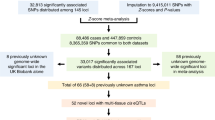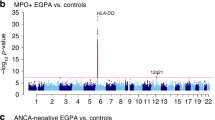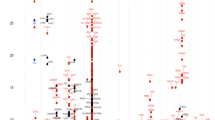Abstract
Immunoglobulin E (IgE) is a central mediator of allergic (atopic) inflammation. Therapies directed against IgE can alleviate hay fever1 and allergic asthma1,2. Genetic association studies have not yet identified novel therapeutic targets or pathways underlying IgE regulation3,4,5,6. We therefore surveyed epigenetic associations between serum IgE concentrations and methylation at loci concentrated in CpG islands genome wide in 95 nuclear pedigrees, using DNA from peripheral blood leukocytes. We validated positive results in additional families and in subjects from the general population. Here we show replicated associations—with a meta-analysis false discovery rate less than 10−4—between IgE and low methylation at 36 loci. Genes annotated to these loci encode known eosinophil products, and also implicate phospholipid inflammatory mediators, specific transcription factors and mitochondrial proteins. We confirmed that methylation at these loci differed significantly in isolated eosinophils from subjects with and without asthma and high IgE levels. The top three loci accounted for 13% of IgE variation in the primary subject panel, explaining the tenfold higher variance found compared with that derived from large single-nucleotide polymorphism genome-wide association studies3,4. This study identifies novel therapeutic targets and biomarkers for patient stratification for allergic diseases.
This is a preview of subscription content, access via your institution
Access options
Subscribe to this journal
Receive 51 print issues and online access
$199.00 per year
only $3.90 per issue
Buy this article
- Purchase on Springer Link
- Instant access to full article PDF
Prices may be subject to local taxes which are calculated during checkout



Similar content being viewed by others
References
Holgate, S. T., Djukanovic, R., Casale, T. & Bousquet, J. Anti-immunoglobulin E treatment with omalizumab in allergic diseases: an update on anti-inflammatory activity and clinical efficacy. Clin. Exp. Allergy 35, 408–416 (2005)
Busse, W. W. et al. Randomized trial of omalizumab (anti-IgE) for asthma in inner-city children. N. Engl. J. Med. 364, 1005–1015 (2011)
Weidinger, S. et al. Genome-wide scan on total serum IgE levels identifies FCER1A as novel susceptibility locus. PLoS Genet. 4, e1000166 (2008)
Moffatt, M. F. et al. A large-scale, consortium-based genomewide association study of asthma. N. Engl. J. Med. 363, 1211–1221 (2010)
Levin, A. M. et al. A meta-analysis of genome-wide association studies for serum total IgE in diverse study populations. J. Allergy Clin. Immunol. 131, 1176–1184 (2013)
Granada, M. et al. A genome-wide association study of plasma total IgE concentrations in the Framingham Heart Study. J. Allergy Clin. Immunol. 129, 840–845 (2012)
Nouri-Aria, K. T. et al. Cytokine expression during allergen-induced late nasal responses: IL-4 and IL-5 mRNA is expressed early (at 6 h) predominantly by eosinophils. Clin. Exp. Allergy 30, 1709–1716 (2000)
Deaton, A. M. et al. Cell type-specific DNA methylation at intragenic CpG islands in the immune system. Genome Res. 21, 1074–1086 (2011)
Eckhardt, F. et al. DNA methylation profiling of human chromosomes 6, 20 and 22. Nature Genet. 38, 1378–1385 (2006)
Löhning, M., Richter, A. & Radbruch, A. Cytokine memory of T helper lymphocytes. Adv. Immunol. 80, 115–181 (2002)
Roessler, J. et al. Quantitative cross-validation and content analysis of the 450k DNA methylation array from Illumina, Inc. BMC Res. Notes 5, 210 (2012)
Moffatt, M. F. et al. Genetic variants regulating ORMDL3 expression contribute to the risk of childhood asthma. Nature 448, 470–473 (2007)
Ziyab, A. H. et al. Interactive effect of STAT6 and IL13 gene polymorphisms on eczema status: results from a longitudinal and a cross-sectional study. BMC Med. Genet. 14, 67 (2013)
Laprise, C. The Saguenay-Lac-Saint-Jean asthma familial collection: the genetics of asthma in a young founder population. Genes Immun. 15, 247–255 (2014)
Palmer, L. J. et al. Independent inheritance of serum immunoglobulin E concentrations and airway responsiveness. Am. J. Respir. Crit. Care Med. 161, 1836–1843 (2000)
Tykocinski, L. O. et al. A critical control element for interleukin-4 memory expression in T helper lymphocytes. J. Biol. Chem. 280, 28177–28185 (2005)
Ansel, K. M., Djuretic, I., Tanasa, B. & Rao, A. Regulation of Th2 differentiation and Il4 locus accessibility. Annu. Rev. Immunol. 24, 607–656 (2006)
Relton, C. L. & Davey Smith, G. Two-step epigenetic Mendelian randomization: a strategy for establishing the causal role of epigenetic processes in pathways to disease. Int. J. Epidemiol. 41, 161–176 (2012)
Lopez, A. F. et al. Recombinant human interleukin 5 is a selective activator of human eosinophil function. J. Exp. Med. 167, 219–224 (1988)
Kita, H. Eosinophils: multifaceted biological properties and roles in health and disease. Immunol. Rev. 242, 161–177 (2011)
Reinius, L. E. et al. Differential DNA methylation in purified human blood cells: implications for cell lineage and studies on disease susceptibility. PLoS ONE 7, e41361 (2012)
Holt, P. G., Strickland, D. H., Wikstrom, M. E. & Jahnsen, F. L. Regulation of immunological homeostasis in the respiratory tract. Nature Rev. Immunol. 8, 142–152 (2008)
Houseman, E. A. et al. DNA methylation arrays as surrogate measures of cell mixture distribution. BMC Bioinformatics 13, 86 (2012)
Shindou, H. et al. A single enzyme catalyzes both platelet-activating factor production and membrane biogenesis of inflammatory cells. Cloning and characterization of acetyl-CoA:LYSO-PAF acetyltransferase. J. Biol. Chem. 282, 6532–6539 (2007)
Kruse, S. et al. The Ile198Thr and Ala379Val variants of plasmatic PAF-acetylhydrolase impair catalytical activities and are associated with atopy and asthma. Am. J. Hum. Genet. 66, 1522–1530 (2000)
Peachman, K. K., Lyles, D. S. & Bass, D. A. Mitochondria in eosinophils: functional role in apoptosis but not respiration. Proc. Natl Acad. Sci. USA 98, 1717–1722 (2001)
Chu, V. T. et al. Eosinophils are required for the maintenance of plasma cells in the bone marrow. Nature Immunol. 12, 151–159 (2011)
Pavord, I. D. et al. Mepolizumab for severe eosinophilic asthma (DREAM): a multicentre, double-blind, placebo-controlled trial. Lancet 380, 651–659 (2012)
Breitling, L. P., Yang, R., Korn, B., Burwinkel, B. & Brenner, H. Tobacco-smoking-related differential DNA methylation: 27K discovery and replication. Am. J. Hum. Genet. 88, 450–457 (2011)
Wan, E. S. et al. Cigarette smoking behaviors and time since quitting are associated with differential DNA methylation across the human genome. Hum. Mol. Genet. 21, 3073–3082 (2012)
Touleimat, N. & Tost, J. Complete pipeline for Infinium((R)) Human Methylation 450K BeadChip data processing using subset quantile normalization for accurate DNA methylation estimation. Epigenomics 4, 325–341 (2012)
Du, P., Kibbe, W. A. & Lin, S. M. lumi: a pipeline for processing Illumina microarray. Bioinformatics 24, 1547–1548 (2008)
Ferland, C. et al. Eotaxin promotes eosinophil transmigration via the activation of the plasminogen-plasmin system. J. Leukoc. Biol. 69, 772–778 (2001)
Willer, C. J., Li, Y. & Abecasis, G. R. METAL: fast and efficient meta-analysis of genomewide association scans. Bioinformatics 26, 2190–2191 (2010)
Howie, B., Fuchsberger, C., Stephens, M., Marchini, J. & Abecasis, G. R. Fast and accurate genotype imputation in genome-wide association studies through pre-phasing. Nature Genet. 44, 955–959 (2012)
Lawlor, D. A., Harbord, R. M., Sterne, J. A., Timpson, N. & Davey Smith, G. Mendelian randomization: using genes as instruments for making causal inferences in epidemiology. Stat. Med. 27, 1133–1163 (2008)
Acknowledgements
This work was supported by the Freemasons’ Grand Charity. The study was also funded by the Wellcome Trust under grants WT 077959 and WT096964, the UK Medical Research Council, a grant to G.M.L. from Génome Québec, le Ministère de l’Enseignement supérieur, de la Recherche, de la Science et de la Technologie (MESRST), Québec and McGill University, and the National Institutes of Health R01s HL101251-01 and P01-ES18181. M.F.M. and W.O.C.M.C. are Joint Wellcome Trust Senior Investigators, W.O.C.M.C. is a National Institute for Health Research Senior Investigator and C.L. is the Chairholder of the Canada Research Chair on Genetic Determinants in Asthma. We thank A.-M. Madore and V. T. Vaillancourt for the eosinophil isolation and M. Laviolette and N. Flamand for their advice on this technique.
Author information
Authors and Affiliations
Contributions
S.A.G.W.-O., W.O.C.M.C., G.M.L. and M.F.M. planned the initial study. S.A.G.W.-O., A.B. and K.C.C.W. performed measurements of methylation status. L.L. and W.O.C.M.C. led statistical analyses of the data with S.A.G.W.-O. and G.M.L.: most analyses were carried out by L.L. G.M.L. and T.M.P. led discussions on replication strategy, methylation assays and cell-specific methylation, with contributions from M.F.M., D.A.S. and I.V.Y. E.G. validated Ilumina probes with bisulphite sequencing. C.L. led studies of SLSJ families with T.J.H., and G.A.D. and J.M.H. led studies of the PAPA subjects. C.L. led studies of isolated eosinophils. M.H., L.R. and S.B. recruited subjects and studied lymphocyte subsets. W.O.C.M.C. wrote the first draft of the paper. All authors contributed to the interpretation of the results and the writing of the paper.
Corresponding author
Ethics declarations
Competing interests
The authors declare no competing financial interests.
Extended data figures and tables
Extended Data Figure 1 Concordance in methylation status at IgE-associated loci when comparing whole-genome bisulphite sequencing with the Illumina platform.
These results were produced by us (E.G. and T.M.P.) at the Genome Québec Innovation Centre. The figures show a comparison between IgE-associated CpG probes using Illumina 450K (x-axis) and whole-genome bisulphite sequencing (WGBS) (y-axis) platforms for two samples (left and right panels) with 20-fold sequence coverage. The results show a high R2 between platforms (0.76 and 0.73). The median of the correlation coefficients for our IgE-associated loci across 30 different samples (using WGBS at various depths) was R2 = 0.76. This can be compared with the global assessment of all overlapping 450K sites, which is R2 = 0.81.
Extended Data Figure 2 Distribution of methylation status at IgE-associated loci in isolated leukocyte subsets.
a–l, The figure shows the distribution of methylation in PBL subsets at the most strongly IgE-associated loci. CpG methylation was measured by the Illumina Infinium 450K platform. Boxplots show means and interquartile ranges. a, c, e, g, i, k, Results from publically available data derived from six healthy controls21. Lower levels of methylation with wider variation are observed in eosinophils when compared to whole blood (WB) and subsets comprising CD14+ monocytes (CD14+M); CD19+ B cells (CD19+B); CD4+ T cells (CD4+T); CD56+ natural killer cells (CD56+NK); CD8+ T cells (CD8+T); granulocytes (Gran); neutrophils (Neu) and peripheral blood mononuclear cells (PBMCs). b, d, f, h, j, l, Results from cells isolated and analysed by us at the McGill University Genome Québec Innovation Centre (MUGQIC). Eosinophils (Eos) (from 24 subjects in the SLSJ panel) also show lower levels of methylation with wider variation compared to whole blood (22 SLSJ subjects), and to subsets including B cells (BC; 9 control subjects), monocytes (Mono; 76 control subjects) and T cells (TC; 74 control subjects). KW Test, Kruskal–Wallis one-way analysis of variance.
Extended Data Figure 3 Power estimations to detect eosinophil-specific effects in DNA from PBL.
The figure shows that our original MRCA data set (green line) and our combined data set (blue line) are well powered to detect signals of the magnitude observed in our three groups of subjects. The red line shows the power of a sample size of six, as described previously21, to detect differences in CpG methylation in unfractionated PBLs. The mean variance (as standard deviation (s.d.)) for the IgE-associated loci was 0.036 in PBLs from our primary MRCA panel and 0.023 in the whole blood normal samples from ref. 21, demonstrating that our results were consistent with the previous experiment.
Supplementary information
Supplementary Tables
This file contains Supplementary Table 1. (XLSX 24 kb)
Supplementary Tables
This file contains Supplementary Table 2. (XLSX 29 kb)
Supplementary Tables
This file contains Supplementary Table 3. (CSV 134 kb)
Supplementary Tables
This file contains Supplementary Table 4. (CSV 72 kb)
Supplementary Tables
This file contains Supplementary Table 5. (CSV 75 kb)
Rights and permissions
About this article
Cite this article
Liang, L., Willis-Owen, S., Laprise, C. et al. An epigenome-wide association study of total serum immunoglobulin E concentration. Nature 520, 670–674 (2015). https://doi.org/10.1038/nature14125
Received:
Accepted:
Published:
Issue Date:
DOI: https://doi.org/10.1038/nature14125
This article is cited by
-
Transcriptome analysis of peripheral whole blood identifies crucial lncRNAs implicated in childhood asthma
BMC Medical Genomics (2020)
-
Multi-method genome- and epigenome-wide studies of inflammatory protein levels in healthy older adults
Genome Medicine (2020)
-
Whole-genome bisulfite sequencing in systemic sclerosis provides novel targets to understand disease pathogenesis
BMC Medical Genomics (2019)
-
Epigenome-wide association study of total serum immunoglobulin E in children: a life course approach
Clinical Epigenetics (2018)
-
Multiancestry association study identifies new asthma risk loci that colocalize with immune-cell enhancer marks
Nature Genetics (2018)
Comments
By submitting a comment you agree to abide by our Terms and Community Guidelines. If you find something abusive or that does not comply with our terms or guidelines please flag it as inappropriate.



